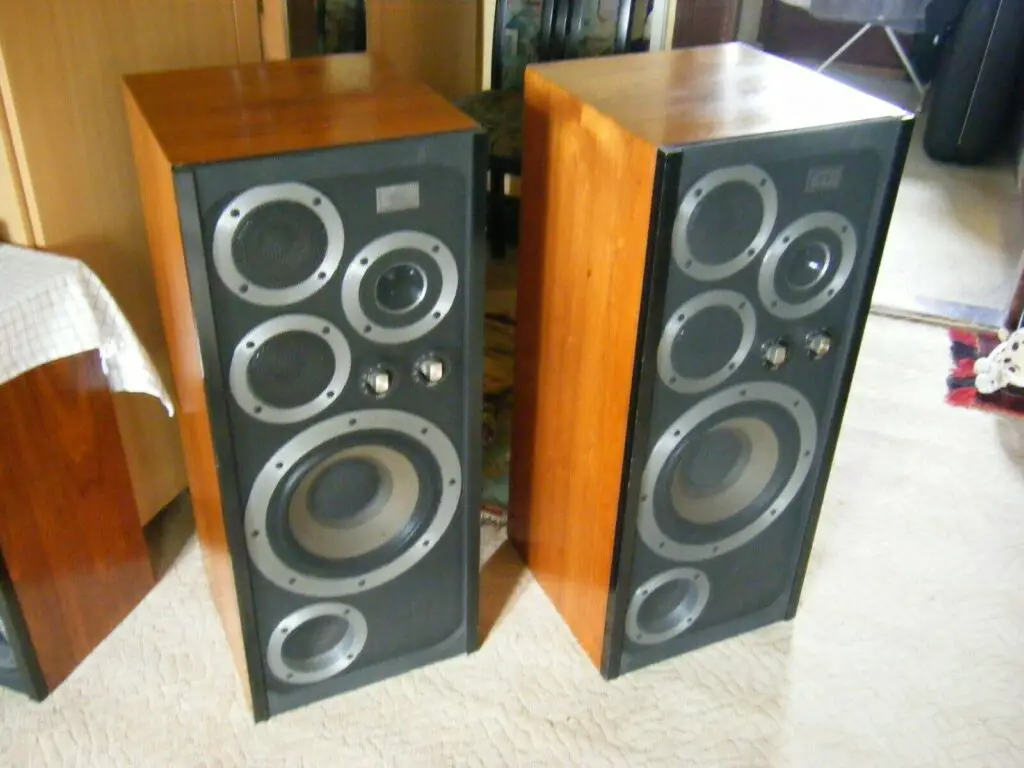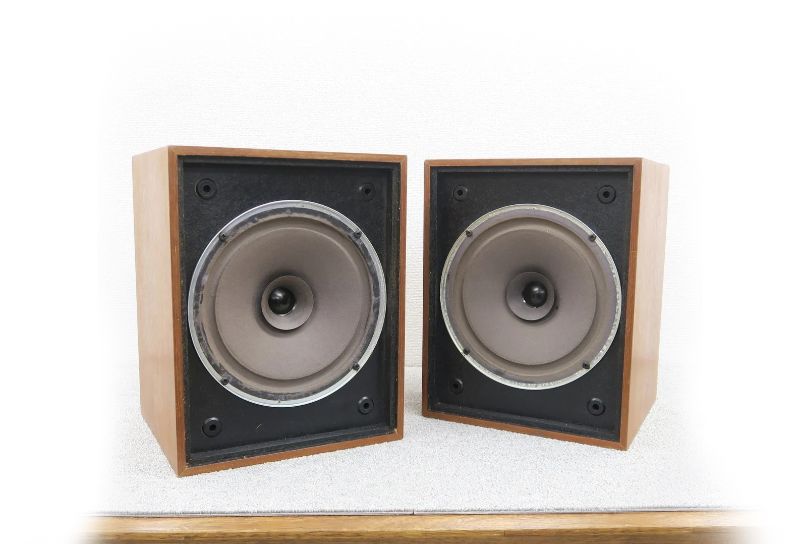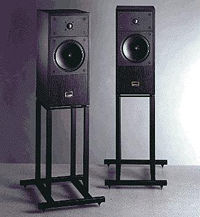Sony’s La Scala 1 system, which was released in the UK in 1995 and cost roughly £1,500 at the time, was later lowered to much less. The CDP-S1 CD player, optional MD-S1 MiniDisc recorder, TC-S1 cassette deck, ST-S1 tuner, and TAE-S1 preamp were all included. A pair of SA-S1 active speakers completed the kit, resulting in a versatile, high-quality midi system with far more technology than its competitors. If we’re being honest, the speakers were the show’s main attraction. According to reports, they accounted for three-quarters of the entire system cost.
The SA-appearance S1’s throws you a curve ball at first glance. Any audiophile worth their interconnects will immediately recognize the electrostatic tweeter that sits atop an otherwise unassuming boxy speaker cabinet. This is a significant achievement for any hi-fi speaker, regardless of type or price – let alone one offered as part of a stack system. The 25x100mm treble unit has an electrostatic design that can output up to 8W RMS. The diaphragm that radiates sound in an electrostatic tweeter is significantly lighter than that utilized in a traditional dome tweeter, as you are aware, dear reader. That means less distortion and faster transients, as well as better dispersion.
Normally, that would suffice for any loudspeaker – electrostatic/moving coil hybrids are uncommon. The SA-S1 didn’t end there, as it also had a 170mm bass unit using a variation of Sony’s highly regarded but rarely utilized motional feedback (MFB) system. This amplifier unit pumped out a stated 50W RMS and was coupled to a complex system that electronically monitored and corrected for cone behavior in real time.
Motional feedback, like four-wheel steering in cars, was a very sophisticated and effective concept that failed in the commercial market because it was too costly to make and difficult to market. The system received critical acclaim from the press when Philips released their motional feedback speakers in the mid-to-late 1970s, but it simply did not sell at the dealers — owing to the higher price and complexity. Funny enough, Honda encountered the same problem with its four-wheel steering system in the Prelude coupe ten years later.
A second voice coil wound onto the bass driver is used in Sony’s motional feedback configuration. This is the same methodology used in today’s MFB subwoofers — it’s a little less effective than the original Philips method and a little easier. This is used to provide bass correction to compensate for the cone’s mechanical loss, and is controlled by an analogue equalization network housed in a plug-in module inside the loudspeaker cabinet of the SA-S1.
The power amplifier is based on a STK-type hybrid chip that operates in Class AB2, with the bias current configured at the factory. The power chip in this speaker is a stereo version, with one channel for the woofer and the other for the tweeter. The circuit includes a protective circuit with a relay. The 4556 chip, which is typically found in the phono stages of Japanese integrated amplifiers, is used to perform MFB correction, low-level amplification, and crossover equalization in op-amp stages. It’s noteworthy that Sony engineers used a plug-in module for the EQ section, presumably so that they could readily repurpose the design for various applications?
The speakers are 220x500x345mm in size and weigh 11kg each. It has a satin lacquered dark brown lower cabinet with a plastic front baffle molding and a small rear-mounted reflex port. The speaker has a single front-mounted power switch, as well as a single RCA unbalanced phono input and a figure-of-8 IEC power socket on the back panel. The SA-S1 has excellent overall build quality, far superior to any other ‘midi system speaker’ I’ve ever seen, if not quite up to the standards of high-end hi-fi designs.
You’ll need two things to get the most out of the Sony SA-S1: a competent preamplifier and a decent pair of speaker supports. I used an MF Audio Passive Preamplifier, which was fed by a Chord Hugo TT2 DAC, and a set of Atacama SE16 stands, which brought the tweeters up to virtually ear height in my room. These active speakers operate best when placed near the front of the room, which seems paradoxical given that they’re intended to be midi-system speakers that are frequently slammed against a back wall. If you choose the latter, you’ll probably end up with a sassy presentation that many people will enjoy, but one I found a touch too aggressive. Although Sony does not specify a frequency response, there was a lot of bass energy around 100Hz, far more than you’d anticipate from a speaker this tiny. The speakers seemed to breathe better when they were moved 60cm or more into the room, and even the electrostatic treble unit seemed to be more effective.
When properly installed, you’ll hear a unique sound that’s unlike anything else on the market. In a nutshell, it’s silky but powerful, smart but fearless, and delicate yet expansive. There are two features that stick out: the treble is finely carved and open, and the bass response is far more seismic than you’d think. Overall, the Sony SA-S1 has a constant energy that hurls music at you, but it doesn’t sound unpleasant. It does, however, serve as a reminder of how lifeless and limp many traditional stand mounters may sound. This is partly owing to the active design, but the motional feedback mechanism, which simply keeps pushing hard, amplifies the effect. The result is a barrel-chested performance that keeps blasting music at you, yet it’s far from barbaric.
Let’s start with some classic technopop, courtesy of YMO, the Japanese electro pioneers. Ballet, more than most other music I’ve heard, demonstrated this speaker’s distinctive combination of subtlety and grip. The SA-S1 blasted out the chunky sequenced bassline with amazing strength and dynamics, putting us well in ‘velvet glove’ zone. The bass’s power is undeniable.
That synth line was tight and taut, and varied up and down in a tuneful way, so it wasn’t simply a giant blob of bass. At the same time, it didn’t drown out the rest of the song, so I could hear the lead vocal line and the haunting backing track well. Then there was the electronic hi-hat sound, which was delicate and rapid without being harsh, smeared, or splashed. The overall effect was unusual in the sense that you usually only hear huge, powerful speakers or smooth, slimline speakers, not both.
Kate Bush’s female vocals were very impressive. Cloudbusting was open and expressive, and I was struck by how lively this speaker’s presentation was. Although the strong electronic percussion didn’t take over the track, it sounded energetic, aggressive, and expressive. Instead, there was a good feeling of rhythm, but there was also a lot of space surrounding Kate’s mesmerizing singing. Again, the Sony paid specific attention to the bass and snare drum work; it seemed to embrace the task of conveying strong drum hits, but there was no impression that this speaker was merely a crude bruiser capable of pumping out boring thrash metal. Although it has a huge fist, it is hidden by the velvet glove mentioned earlier.
The SA-S1 is a great spatial performer, as you’d expect from an electrostatic tweeter. It’s far superior to the usual box loudspeaker, albeit it doesn’t quite match the Quad ESL-57’s ability to ‘disappear in front of your very ears.’ This is owing in part to a slight boxy coloration emanating from the main loudspeaker enclosure, which is adequate but nonetheless made on a budget. Even so, feed the speaker some expansive-sounding 1960s rock music like The Byrds’ Eight Miles High, and you’ll discover the world sounds larger than most conventional speakers of the same size. There’s a lot of nuance here; instruments are properly situated, and there’s even a reasonable attempt at a three-dimensional soundstage, with the recorded acoustic hanging back a bit – rather than being shoved in your face like so many other mid-price box speakers of the time.
It’s a curious creature, and it sounds a lot like it looks. How funny that one of the most adventurous active speakers of the 1990s ended up being sold merely as an add-on to a mid-priced midi system that was neat looking and decently manufactured but nothing special!
These things aren’t as common as, example, a pair of Mission 780s from the same era – but if you keep looking, you’ll find more than you think. All of the normal restrictions apply here: when buying vintage loudspeakers, check sure the drive units are working as they should, that the rubber roll surrounds aren’t perished, and so forth. The electronics inside must also be in good working order; relays tend to tarnish, resulting in distortion and/or dropouts. As a result, you should obtain a description of any potential pair you are considering purchasing. Some may be put off by the price, but at between £200 and £300 for a good pair, they’re an audiophile bargain.
For the most part, Sony is associated with mass market Walkman and PlayStation goods rather than high-end and/or innovatively constructed loudspeakers. However, this Japanese behemoth has a track record in this area, and has used its vast engineering resources to create beautiful statement pieces on occasion.
It was clearly interested in electrostatics from the start, as evidenced by its SS-7000, a bizarre rebadging of B&W’s long-lost DM-70 Continental electrostatic from 1973. However, the company’s crowning achievement occurred on February 1, 1996, when the SS-R10 full range flagship electrostatic was introduced. This was and still is Sony’s most costly speaker (at 1,500,000 Yen per, or around £10,000 back then) – it is a sight for sore ears!
It is said to be a one-of-a-kind project built by one skilled engineer, similar to the company’s previous SS-G333ES and SS-G777ES speakers, which were pure electrostatic designs with no help from moving coil drivers. It effectively pushed the Quad ESL 57 electrostatic paradigm to its limits.
Its solid timber structure spanned 1545x805x496mm and weighed 76kg, making it a true behemoth. Four 270x50mm treble panels, two 25x500mm midrange panels, and two 70x500mm bass panels were included in the package. The frequency response was reported to be 35Hz to 40kHz, with crossover frequencies of 600Hz and 4kHz (-10dB). With a nominal impedance of 4 ohms and a sensitivity of 80dB/W/m, it was a tricky thing to drive. The R1 logo indicated that it was the company’s best-of-the-best, a designation reserved for its ultra-high-end flagship line. Don’t get your hopes up too high, because the basic SA-S1 isn’t easy to come by on eBay.







